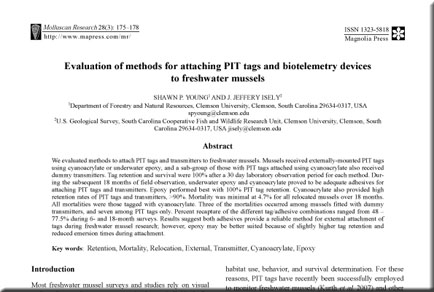Abstract
We evaluated methods to attach PIT tags and transmitters to freshwater mussels. Mussels received externally-mounted PIT tags using cyanoacrylate or underwater epoxy, and a sub-group of those with PIT tags attached using cyanoacrylate also received dummy transmitters. Tag retention and survival were 100% after a 30 day laboratory observation period for each method. During the subsequent 18 months of field observation, underwater epoxy and cyanoacrylate proved to be adequate adhesives for attaching PIT tags and transmitters. Epoxy performed best with 100% PIT tag retention. Cyanoacrylate also provided high retention rates of PIT tags and transmitters, >90%. Mortality was minimal at 4.7% for all relocated mussels over 18 months. All mortalities were those tagged with cyanoacrylate. Three of the mortalities occurred among mussels fitted with dummy transmitters, and seven among PIT tags only. Percent recapture of the different tag/adhesive combinations ranged from 48 – 77.5% during 6- and 18-month surveys. Results suggest both adhesives provide a reliable method for external attachment of tags during freshwater mussel research; however, epoxy may be better suited because of slightly higher tag retention and reduced emersion times during attachment.

